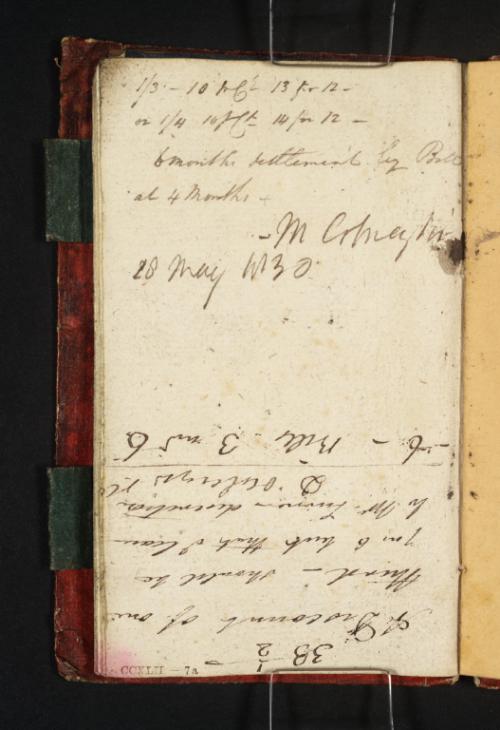Joseph Mallord William Turner Inscriptions by Turner and Others: Notes on Colnaghi Discounts ?1830
Joseph Mallord William Turner,
Inscriptions by Turner and Others: Notes on Colnaghi Discounts
?1830
Joseph Mallord William Turner 1775–1851
Folio 7 Verso:
Inscriptions by Turner and Others: Notes on Colnaghi Discounts ?1830
D22565
Turner Bequest CCXLII 7a
Turner Bequest CCXLII 7a
Ink on white laid paper, 129 x 75 mm
Inscribed by Turner ?and Dominic Colnaghi in ink with financial notes (see main catalogue entry)
Stamped in black ‘CCXLII – 7a’ bottom right
Inscribed by Turner ?and Dominic Colnaghi in ink with financial notes (see main catalogue entry)
Stamped in black ‘CCXLII – 7a’ bottom right
Accepted by the nation as part of the Turner Bequest 1856
References
1909
A.J. Finberg, A Complete Inventory of the Drawings of the Turner Bequest, London 1909, vol.II, p.742, CCXLII 7a, with transcriptions.
At the top end of the page is the following in ink:
1/3 – 10 p Ct 13 for 12 –
or 1/4 – 10 p Ct 14 for 12 –
6 months settlement by Bill
at 4 months
– M Colnaghi
28 May 1830
or 1/4 – 10 p Ct 14 for 12 –
6 months settlement by Bill
at 4 months
– M Colnaghi
28 May 1830
At the opposite end of the page, inverted relative to the sketchbook’s foliation, is the following, also in ink:
33½
A Discount of one
third – should be
7 in 6 but that I leave
to Mr Turners discretion
D [?P] Colnaghi & Co
– 6 – Bills 3 and 6
A Discount of one
third – should be
7 in 6 but that I leave
to Mr Turners discretion
D [?P] Colnaghi & Co
– 6 – Bills 3 and 6
As the most distinctive element among a few rather slight pencil sketches, these passages prompted Finberg to name the present sketchbook ‘Colnaghi’s Account’ in his 1909 Inventory,1 though such scrappy notes hardly constitute conventional accounts.
Colnaghi’s was a London firm of print publishers and art dealers, originally the business of G.B. Torre, who started out in Paris and London in the 1760s. Born near Milan, Paul Colnaghi (1751–1833), worked for Torre, married into his family and took over in the late 1780s, taking his son Dominic Paul (1790–1879) into partnership around 1810; they were based at 23 Cockspur Street, near Charing Cross (and subsequently off Trafalgar Square), from 1799. After a legal dispute with Paul’s other son, Martin, the firm of P. & D. Colnaghi was founded in 1826 at nearby 14 Pall Mall East. Through various mergers and takeovers in the twentieth century, any direct family connection was lost. Martin (died 1851) continued trading in his own right at Cockspur Street in rivalry with his father and brother.2
Allowing for the variability of Turner’s handwriting, it appears that the first passage transcribed above is by him; the name and date which follow in a larger hand may be his also, or (as Finberg thought),3 the signature of Martin Colnaghi. The second passage may all be by or on behalf of Dominic Colnaghi, although the numerals seem cruder, and might be interpolations by Turner.
As a youth in the early 1790s, Turner is said to have hand-coloured prints for Paul Colnaghi,4 though the artist hardly ingratiated himself in later years, offering ungenerous trade discounts on his Liber Studiorum prints of only twenty or ten per cent, eventually reduced to five when Dominic enquired in 1848; for the series see the ‘Liber Studiorum c.1806–24’ section of the present catalogue. Dominic held an exhibition of Turner’s recent illustrations to Byron in 1834, probably initiated by the publisher John Murray rather than the artist himself.5 An earlier ink note, ‘1826 | 23 Augt. Colnaghi Junr set of Libers’, inside the back cover of the Loire, Tours, Orleans and Paris sketchbook (Tate D41042; Turner Bequest CCXLIX) was transcribed by Finberg without comment, other than as an aid to dating that sketchbook.6 Ian Warrell has suggested that Turner made the note while in Paris in 1826, either from correspondence waiting for him there or through personal contact with either one of the Colnaghi sons, who could have been there on business.7
A random note in the 1831 Abbotsford sketchbook (Tate D25945; Turner Bequest CCLXVII 10a) was transcribed by Finberg as ‘26 . 12 . 6. Colnaghi’s Feb. 5.’;8 in his entry in the present catalogue, Thomas Ardill has doubted the reading, although Finberg’s seems a reasonable interpretation. It would seem to indicate an amount of £26 12s 6d (twenty-six pounds, twelve shillings and sixpence) owing or paid to the firm on that date, perhaps within a year or two of the notes in the present book. The meaning of the discounts apparently being negotiated here with each Colnaghi firm is unclear, but it would be ironic if Turner were trying to get sums he owed significantly reduced, given the lack of quid pro quo spirit on his part.
Matthew Imms
May 2014
See Jeremy Howard (ed.), ‘Colnaghi: The History’, Colnaghi, accessed 28 February 2014, http://www.colnaghi.co.uk/sites/default/files/cataloguehistory.pdf ; and ‘Colnaghi (Biographical details)’, The British Museum, accessed 28 February 2013, https://www.britishmuseum.org/research/search_the_collection_database/term_details.aspx?bioId=128766 .
See for example Officer of the Third Regiment of Foot Guards, an outline etching by Thomas Kirk after Edward Dayes, ‘Coloured for Colnaghi’ by Turner according to the inscription on the verso (British Museum, London): Martin Butlin, Andrew Wilton and John Gage, Turner 1775–1851, exhibition catalogue, Royal Academy, London 1974, p.176 no.B13, reproduced p.177.
See Evelyn Joll, ‘Colnaghi, Dominic (1790–1879)’ in Joll, Martin Butlin and Luke Herrmann (eds.), The Oxford Companion to J.M.W. Turner, Oxford 2001, p.52.
How to cite
Matthew Imms, ‘Inscriptions by Turner and Others: Notes on Colnaghi Discounts ?1830 by Joseph Mallord William Turner’, catalogue entry, May 2014, in David Blayney Brown (ed.), J.M.W. Turner: Sketchbooks, Drawings and Watercolours, Tate Research Publication, September 2014, https://www

